
views
- Find the comet’s current position at in-the-sky.org. Use the visibility graph to select a time for viewing, then refer to the star chart when pointing your telescope.
- Use a telescope with an aperture of 12.5 in. (32 cm) or larger. The comet will appear as a faint smudge and will be visible to amateur telescopes until early 2024.
- Observe the comet on a clear, moonless night, far from city lights. View the comet when it’s high above the horizon 2 hours after sunset or 2 hours before sunrise.
Locating Comet C/2022 E3 (ZTF) in the Night Sky
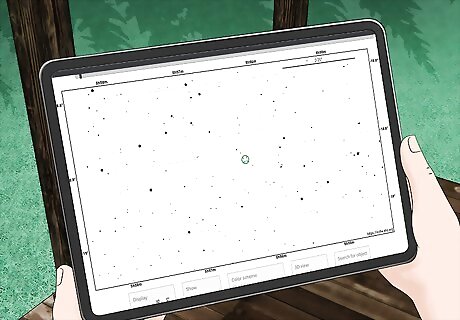
Find the comet’s current position in the sky at in-the-sky.org. Visit the object tracking page for Comet C/2022 E3 (ZTF) on in-the-sky.org. Note the star map with the green circle indicating the comet’s location next to other stars. Scroll down to the bottom of the page to view the visibility graph indicating what times the comet will be visible from your location and how far above the horizon it will be. Note your viewing location on the right side of the page, next to the star map. You should see your current town/city, or a nearby one. If you see the wrong location, click “change location,” enter your town/city under “Choose a town,” and click “Set location.” Then reload the Comet C/2022 E3 (ZTF) tracking page to see viewing details for your location. Examine the chart on the left showing the comet’s magnitude (that is, its brightness) and the constellation where it’s located in the sky. You’ll use this constellation as a reference in the next steps. The visibility graph at the bottom of the page has axes for Altitude (in degrees above the horizon) and time (in 24-hour format). The red line indicates how many degrees the comet appears above the horizon at a specific time. You’ll use this graph in the next steps.
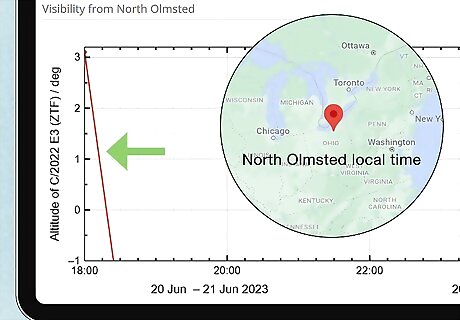
Use the visibility graph to choose a time to view the comet. Examine the red line to determine when the comet will be visible, and how far above the horizon it will appear. The graph provides viewing data for the hours of 18:00-06:00 (6:00 PM - 6:00 AM, on the y-axis), and the comet’s corresponding “Altitude” in degrees above the horizon (on the x-axis). Choose a point on the red line and note the time and Altitude for your observation. For example, if a point on the red line corresponds to 23:30 and 60 deg, this means that the comet will be visible at 23:30 (11:30 PM) at an Altitude of 60 degrees above the horizon. The Altitude may range from 0-90 degrees above the horizon. 0 deg = the horizon itself, while 90 deg = the point directly overhead. 45 deg = halfway between the horizon and the point directly overhead. If you don’t see a red line on the graph, the comet is not currently visible from your location. If the line drops to 0 deg, it means the comet falls below the horizon at that time and is no longer visible.
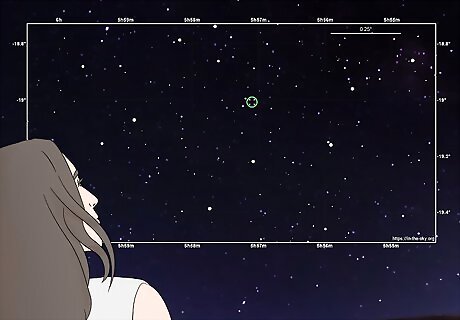
Use the star map to find the comet’s exact position in the sky. Observe the sky at the time you selected from the visibility graph. Tilt your head upward to view the area of the sky corresponding to the comet’s Altitude (degrees above the horizon) for the viewing time you selected. Find the constellation from the star map, then identify 2-3 specific stars closest to the comet’s position. These 2-3 stars will serve as reference points for pointing your telescope or binoculars during the next steps. If you can’t find the constellation in the sky, go to Stellarium-Web.org and select “Near” on the bottom left to input your current location. Then input the constellation’s name into the search bar to find its exact position in the sky. Use a magnetic compass or compass app to determine North, South, East, and West. Use these cardinal directions, plus the info from Stellarium-Web.org, to find the constellation.
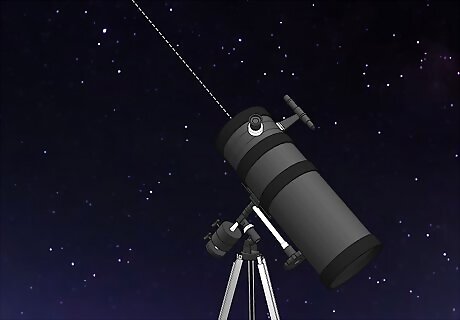
Point a telescope at the comet’s exact position. The comet should appear as a faint, pale smudge. If you can’t find it, point your telescope at a star close to the comet’s position on the star map, then slowly move the telescope to scan the area until you locate the comet. Once you locate it, swap in a more powerful eyepiece (if you have one) to zoom in and see the comet in greater detail. If your telescope has a tracking mount, set it to match the Earth’s rotation. This will keep the comet in your telescope’s field of view, without requiring you to move the telescope. Binoculars are not powerful enough to see the comet.
How to Have a Great Viewing Experience
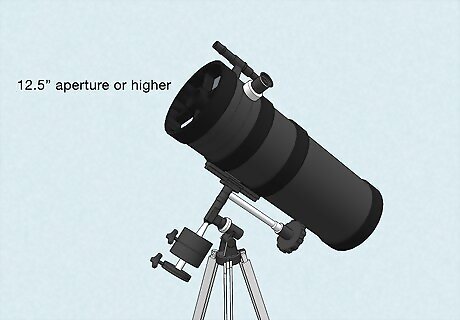
Use a telescope with an aperture of 12.5 inches (32 cm) or larger. This will allow you to see C/2022 E3 (ZTF) for most of 2023. However, as of mid-2023, its magnitude has already faded to 13+ and is slowly increasing. The larger the magnitude, the fainter the comet becomes. As time passes, you’ll need a larger and larger telescope to be able to see it. By February 2024, the comet will become invisible to most amateur telescopes since its magnitude will exceed 17.5.
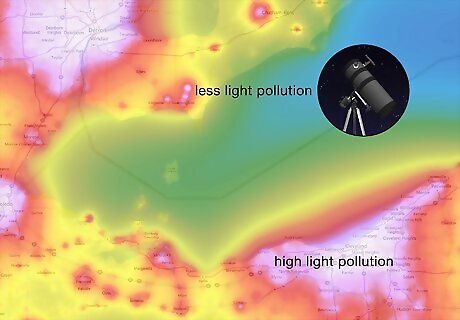
Choose a remote viewing location far from urban lights. Light pollution from cities, streetlights, car headlamps, and campfires can be a real nuisance for stargazers. Visit LightPollutionMap.info to find nearby areas with minimal light pollution. Input your location, then drag the map to find areas highlighted in blue, gray, or black. These areas have less light pollution and are ideal for stargazing. Avoid areas highlighted in yellow, orange, red, or white. These are urban centers with intense light pollution. If possible, visit an official dark sky site for perfect viewing conditions. Visit DarkSkyFinder.com to view a map of dark sky sites worldwide.
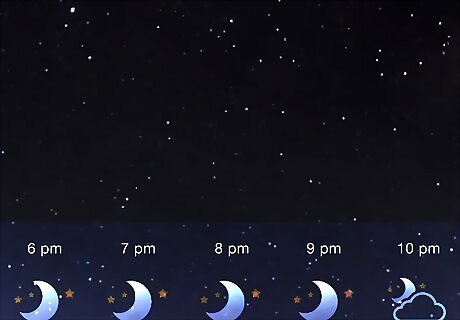
Observe the comet on a clear, moonless night. Moonlight—especially from a full moon—can outshine faint objects and make them hard to see. Wait until the moon sets before viewing the comet to ensure the sky will be fully dark. Check your local weather to make sure there are no clouds to obscure your view. To determine moonrise and moonset times, input your location into TimeAndDate.com’s moon tracker. If you prefer a completely moonless night, check TimeAndDate.com’s lunar phase tracker to find out when the next “New Moon” occurs.
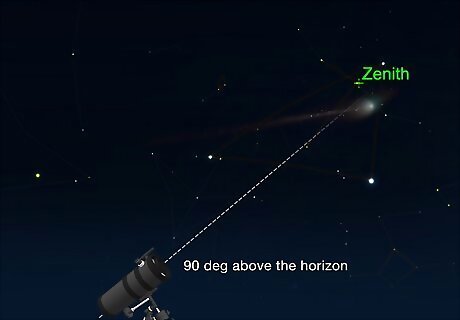
Observe the comet when it’s high above the horizon. Objects far above the horizon appear clear and bright, while objects closer to the horizon appear fainter and redder (this is why sunsets look red) For the best view, observe the comet when it’s close to the “zenith”—the point directly overhead, 90 deg above the horizon. For instance, if the visibility graph shows the comet will be visible tonight at 23:00 (11:00 PM) at 80 deg, and again at 02:30 (2:30 AM) at 30 deg, try to view it at 23:00 (11:00 PM) since it will be much higher above the horizon.
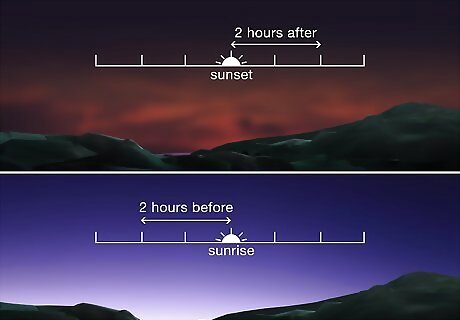
Choose a viewing time 2 hours after sunset, or 2 hours before sunrise. This ensures the sky will be fully dark with no traces of sunlight. Enter your city at TimeAndDate.com to determine the sunrise and sunset times for your location, then choose a viewing time accordingly. Remember that the comet is only visible within the timeframe specified by the visibility graph.
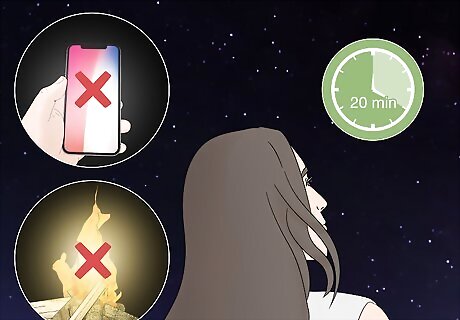
Let your eyes adjust to the dark for 20 minutes. Avoid using phones, flashlights, campfires, or any artificial light sources. After 20 minutes, your eyes will be able to see more clearly with minimal light, making stargazing much easier. Use a red flashlight to help you see in the dark. Unlike normal light, red light won’t cause your eyes to lose their low-light sensitivity.
Other Astronomical Events to Look Out For
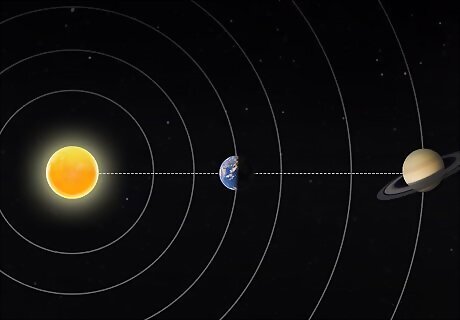
Saturn at Opposition (August 2023) On August 27, Saturn will be in a special location along its orbit called “opposition,” directly opposite the Sun in Earth’s sky. This means Saturn will be visible for the entire night, from sunset to sunrise, and you’ll easily be able to see its rings and moons with a small telescope. Choose a cloudless, moonless night to view Saturn in all its glory. Under ideal conditions, you may be able to see bands of clouds in its atmosphere if your telescope is large enough.
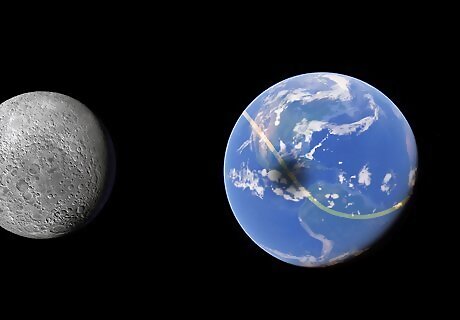
Annular Solar Eclipse (October 14, 2024) Folks in the western USA, Central America, and northern South America will witness an “annular” eclipse: a type of solar eclipse where the moon sits inside of the sun instead of blocking it completely, forming a bright ring around the moon in the daytime sky. Eclipses like these occur when the moon is farthest from Earth, making it appear slightly smaller and preventing it from fully blocking the sun. Visit TimeAndDate.com’s eclipse tracker to find the best spots to view the eclipse.
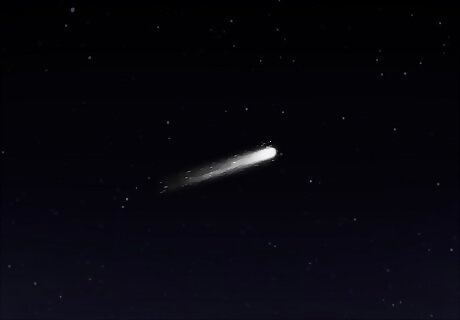
Comet 12P/Pons-Brooks (Early 2024) This comet is a regular visitor to the Inner Solar System, coming close to the sun every 71 years. It’ll start to shine with a magnitude of 7.8 in March and April of 2024, passing closest to Earth in July. Though it won’t be as bright as Comet C 2022 E3, it’ll still be visible on clear nights, especially through binoculars or a small telescope. Track 12P/Pons-Brooks’ current location on In-The-Sky.org
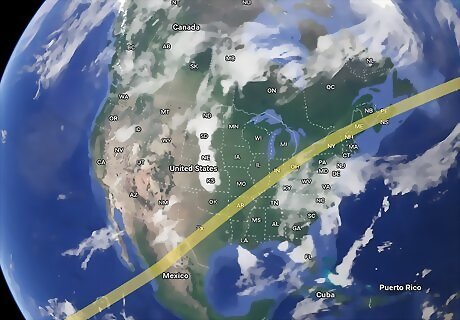
Total Solar Eclipse (April 8, 2024) Viewers in Northern Mexico, South-central USA, Northeast USA, and Eastern Canada will witness a rare, total eclipse of the sun. If you’re an American, heads up: this will be the last total eclipse over the United States mainland until 2045—so don’t miss it! Check out TimeAndDate.com’s eclipse tracker for the best locations to view the eclipse.
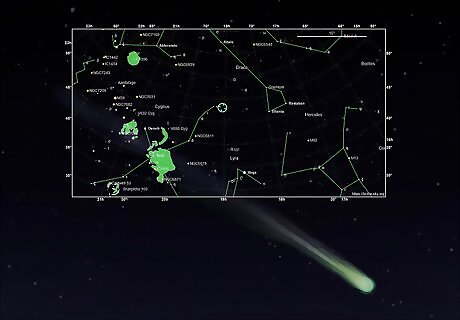
Comet C/2023 A3 (Summer-Fall 2024) This one could shine as brightly as Venus, the brightest object in the night sky after the full Moon. Scientists expect to it become visible to telescopes sometime in June 2024, and it’ll pass close to Earth in mid-October. No word yet on whether it’ll have a tail. Visit Comet C/2023 A3’s page on in-the-sky.org to find its current position.

















Comments
0 comment